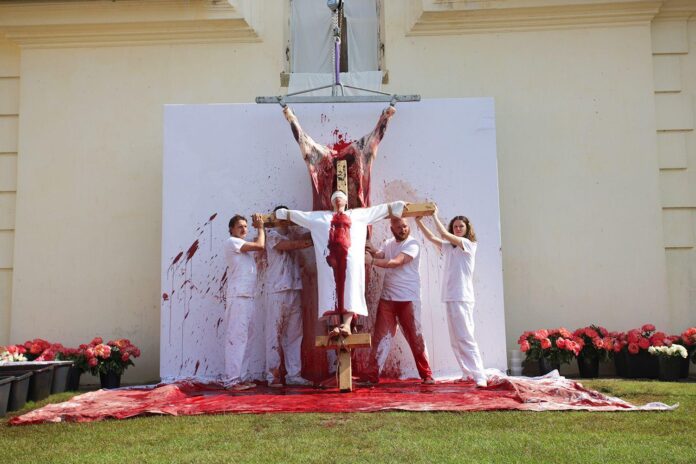The Austrian artist Hermann Nitsch was a founder of, and leading figure in, the short-lived Vienna Actionism movement, which in the 1960s and 1970s staged transgressive, destructive performances involving naked bodies, violence and blood as well as animal sacrifice and crucifixion. Some of the artists even went to jail—Nitsch himself was hauled before the courts three times for violating public decency.
He died in 2022 at the age of 83, but this year under the impetus of his third wife Rita, there was a restaging of what many consider the high point of his work, the Six Day Play orThe Theatre of Orgies and Mysteries, first performed in 1989 to outrage, howls of blasphemy and protests from animal rights organisations.
The first two days were held last year. Then on 28 May this year, over 250 paying guests, 150 musicians and scores of willing, unpaid helpers converged on Prinzendorf castle, a Schloss about an hour from Vienna which Nitsch acquired in 1971 and refurbished, thanks to his second wife.
The peaceful setting surrounded with verdant wheat fields stood in stark contrast to the all-day performance, with its dissonant music, banging of gongs, drums and clanging bells accompanying scenes of gore and general mayhem. Nitsch himself left precise instructions for the day and had composed all the music, including a 287-page score.
While the first performances had featured a live bull being stunned before being slaughtered, this is no longer legal and the corpse of a skinned bull was solemnly brought in, hauled up to form the backdrop to a series of blood-drenched tableaux featuring its entrails, blindfolded naked performers strapped to crosses being ‘fed’ blood and milk and a scrum of performers throwing those entrails plus hundreds of kilos of tomatoes and grapes around, while more blood was flung over them.

Hermann Nitsch, Theatre of Orgies and Mysteries (2023) © Feyerl
It was certainly stomach-churning, with the stench of the guts standing in vivid contrast to the surroundings, where spectators seated at tables tranquilly sipped iced tea and ate apple strudel while they watched. Dotted around the courtyard were thousands of peonies while the air was also perfumed by white-clad performers swinging incense burners.
With the Six-Day Play, Nitsch was creating a Gesamtkunstwerk, a large-scale total work of art calling on the senses—olfactory, visual, auditive. With such actions, the Vienna Actionists —including Günter Brus, Otto Mühl and Rudolf Schwarzkogler—were confronting Austria’s post-war denial of the barbarity of the Second World War. Nitsch himself, while not necessarily very religious, was obsessed with ritual and the Catholic Church, and much of the performance was ritualistic in its unfolding, with a series of staged ‘crucifixions’. After the climax of entrails and blood-flinging, the day ended with catharsis, as night fell and the guests were served a dinner of lentil stew and potato goulash.
While short-lived, Vienna Actionism was very influential on subsequent artists, from Jasper Johns to Paul McCarthy. In 1975 Marina Abramović took part in a Nitsch performance, and her curator was present at this year’s play. Also present were numerous collectors of his work, notably the Austrian businessman Gernot Dolezal as well as Werner and Sonia Trenker, who have acquired over 100 Nitsch works from the past two decades, when the artist was working with colour as opposed to the red (blood and paint) which characterises earlier paintings. “You can’t see [a performance like] this anywhere else in the world,” Sonia said. “All religions are about sacrifice; you can’t ignore the dark side of life and this is about life, all of it.”
Nitsch was long represented by the Austrian Galerie Kandlhofer. The estate is now in the hands of a foundation headed by chief executive officer Gudrun Marecek; Pace gallery now also represents his work, and held an exhibition in New York between 17 March and 29 April this year. The Six Day Play was entirely funded by the foundation and private donors.

























